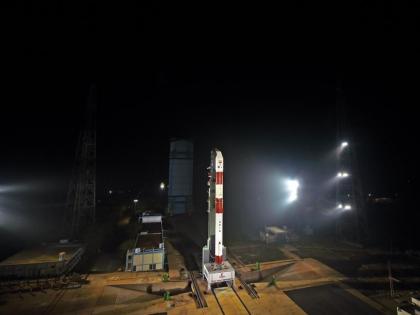ISRO SpaDeX Mission Launched: Indian Space Research Organisation Successfully Launches Space Docking Experiment (Watch Video)
By Lokmat English Desk | Updated: December 30, 2024 22:59 IST2024-12-30T22:43:07+5:302024-12-30T22:59:57+5:30
The Indian Space Research Organisation (ISRO) successfully launched its Space Docking Experiment (SpaDeX) aboard a Polar Satellite Launch Vehicle ...

ISRO SpaDeX Mission Launched: Indian Space Research Organisation Successfully Launches Space Docking Experiment (Watch Video)
The Indian Space Research Organisation (ISRO) successfully launched its Space Docking Experiment (SpaDeX) aboard a Polar Satellite Launch Vehicle (PSLV) from the Satish Dhawan Space Centre on Monday. A video of the highly-awaited SpaDeX Mission launch by ISRO has surfaced on social media.
Watch Video Here:
#WATCH | Indian Space Research Organisation (ISRO) launches PSLV-C60 with SpaDeX and innovative payloads from Sriharikota, Andhra Pradesh. First stage performance normal
— ANI (@ANI) December 30, 2024
SpaDeX mission is a cost-effective technology demonstrator mission for the demonstration of in-space docking… pic.twitter.com/ctPNQh4IUO
"I am really happy to announce the successful accomplishment of the launch of PSLV-C60 for the SpaDeX mission. The rocket has placed the satellite in the correct 475 km circular orbit. That's just one part of the mission," ISRO chairman, S Somanath said.
VIDEO | "I am really happy to announce the successful accomplishment of the launch of PSLV-C60 for the SpaDeX mission. The rocket has placed the satellite in the correct 475 km circular orbit. That's just one part of the mission," says ISRO chairman, S Somanath.
— Press Trust of India (@PTI_News) December 30, 2024
(Source: Third… pic.twitter.com/sxYDWDzVkK
The SpaDeX mission aims to demonstrate cost-effective in-space docking technology using two small spacecraft. The spacecraft, named SDX01 (Chaser) and SDX02 (Target), will rendezvous, dock, and undock in a low-Earth circular orbit.
ISRO stated that the mission will develop and test critical technology for future space missions, including autonomous docking. This capability is expected to be vital for upcoming lunar missions, such as Chandrayaan-4, which will operate without Earth-based GNSS support.
The SpaDeX spacecraft were developed by the UR Rao Satellite Centre (URSC) with support from other ISRO centres, including VSSC, LPSC, SAC, IISU, and LEOS.
The PSLV rocket, standing 44.5 meters tall, carried two 220kg spacecraft designed to support space docking, satellite servicing, and interplanetary missions. This launch is seen as a step toward ISRO’s goal of establishing its own space station by 2035.
Although the launch was initially scheduled for 9:58 pm, it was rescheduled to 10 pm, though ISRO has not disclosed the reason for the delay.
The PSLV rocket also carried the PSLV Orbital Experimental Module-4 (POEM-4), which will deploy 24 small payloads into different orbits over the next 90 minutes. Of these payloads, 14 are from ISRO and 10 from academic institutions.
(With inputs from agencies)
Open in app